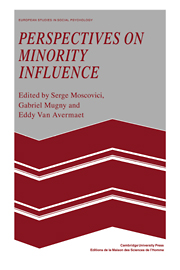Book contents
- Frontmatter
- Contents
- Contributors
- Preface
- Part I The process of minority influence
- Part II Minority influence in groups
- Introduction
- 6 Innovation and socialisation in small groups
- 7 When and how the minority prevails
- 8 The paradox of ‘orthodox minorities’: when orthodoxy infallibly fails
- 9 Conformity, innovation and the psychosocial law
- 10 Infra-group, intra-group and inter-group: construing levels of organisation in social influence
- References
- Subject index
- Author index
10 - Infra-group, intra-group and inter-group: construing levels of organisation in social influence
Published online by Cambridge University Press: 05 February 2012
- Frontmatter
- Contents
- Contributors
- Preface
- Part I The process of minority influence
- Part II Minority influence in groups
- Introduction
- 6 Innovation and socialisation in small groups
- 7 When and how the minority prevails
- 8 The paradox of ‘orthodox minorities’: when orthodoxy infallibly fails
- 9 Conformity, innovation and the psychosocial law
- 10 Infra-group, intra-group and inter-group: construing levels of organisation in social influence
- References
- Subject index
- Author index
Summary
This chapter is an unabashedly speculative essay, though tempered by an effort to use rather than abuse or ignore existing theory and empirical data relevant to the topic. Attempting to stimulate thinking on a problem by offering a generous abundance of suggestions and speculations, while at the same time adhering as closely as possible to the existing scientific literature, is to steer a tenuous course indeed – some would say that such a course runs between Scylla and Charybdis. Even so, I shall try to include evidence obtained both from well-controlled laboratory experiments as well as observations from everyday life in the ‘real world’ which, though not meeting the canons of science, we as psychologists ignore at our peril. Being rather too loose or too rigid would be detrimental to the goal of throwing some light on the dark corners of the old problem of social influence, which has been at the centre stage of social psychology since its beginnings as a science. The ubiquitous impact of social influence on our actions, beliefs and feelings in everyday life is too obvious to require documentation.
With these caveats, I turn directly to problems concerned with the area of social influence exerted by the minority. Several issues will be raised in connection with the general problem, but the basic thrust of the present inquiry is directed towards the consequences of an individual's construing the social environment at different levels of phenomenal organisation.
- Type
- Chapter
- Information
- Perspectives on Minority Influence , pp. 217 - 238Publisher: Cambridge University PressPrint publication year: 1985
- 11
- Cited by



